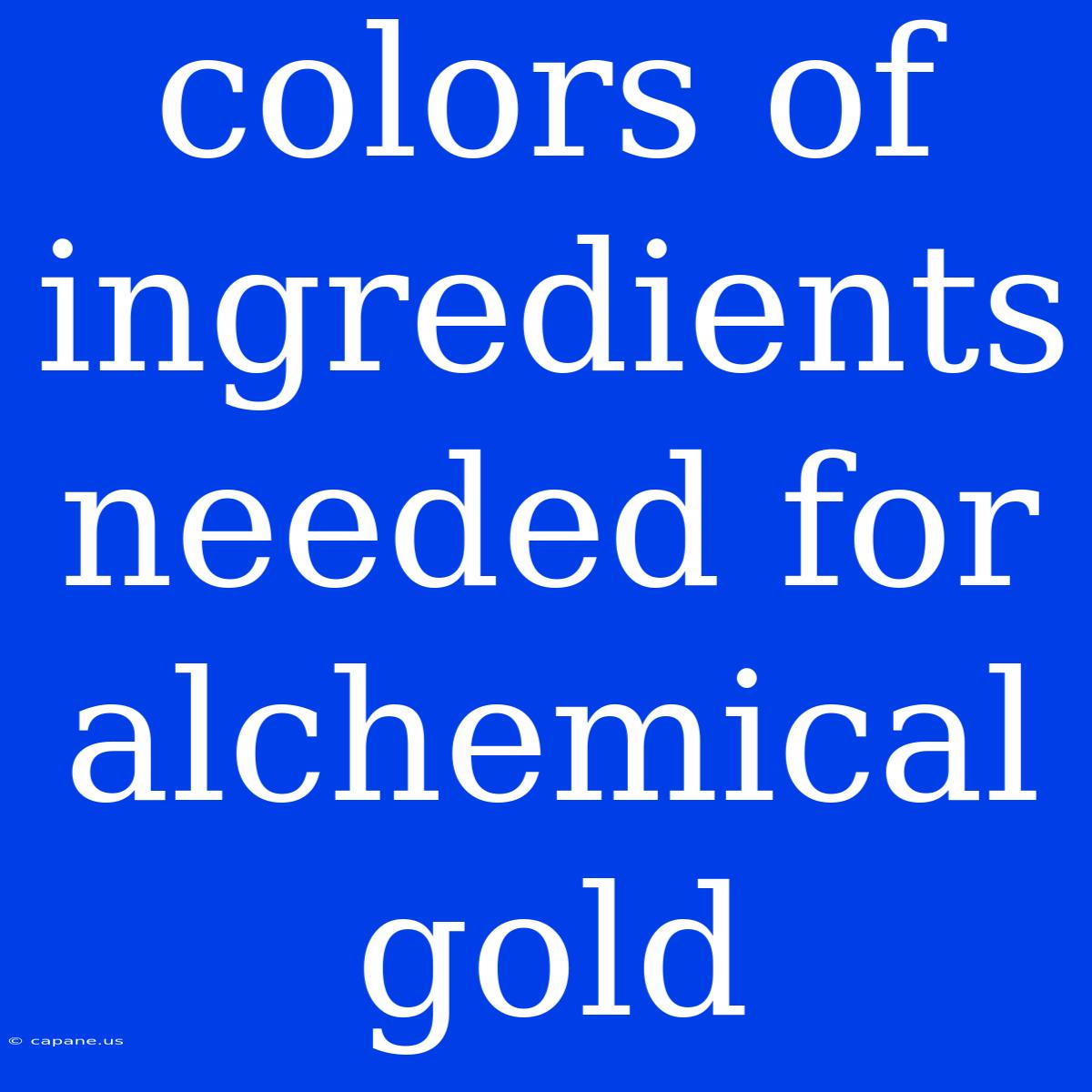The Alchemy of Colors: Unveiling the Hues of Gold-Making Ingredients
Have you ever wondered what colors might be involved in the elusive pursuit of alchemical gold? The very notion of turning base metals into gold has fascinated and mystified humanity for centuries. Though modern science has debunked the possibility of creating gold through conventional alchemy, the process, as envisioned by alchemists, was a complex journey involving a myriad of ingredients, each imbued with symbolic meanings and corresponding colors.
Editor Note: This exploration delves into the colors of ingredients traditionally associated with alchemical gold creation, revealing their symbolic significance and historical context.
Understanding the colors of alchemical ingredients is crucial for grasping the symbolic framework within which alchemists operated. The alchemical process wasn't solely about transforming lead into gold; it was about a spiritual journey of self-discovery and purification. Each color, with its associated ingredient, represented a stage in this transformative process, reflecting both physical and metaphysical aspects.
Our analysis draws upon historical texts, alchemical treatises, and symbolic interpretations to provide a comprehensive overview of the colors associated with alchemical gold-making. While the actual ingredients and their exact ratios remain shrouded in secrecy, the colors offer valuable insights into the alchemists' beliefs and methods.
Key Insights into the Colors of Alchemical Gold-Making:
| Color | Ingredient | Symbolic Meaning |
|---|---|---|
| Black | Lead, Mercury, Carbon | Primordial Chaos, Death, Beginning of Transformation |
| White | Silver, Salt, Antimony | Purity, Purification, Mental Clarity |
| Yellow | Sulfur, Gold | Perfection, Spiritual Illumination, Completion |
| Red | Iron, Blood, Fire | Passion, Energy, Transformation |
| Green | Copper, Vegetation | Growth, Renewal, Life Force |
| Blue | Water, Air | Spirituality, Wisdom, Transcendence |
The Alchemical Journey:
The alchemists, through their intricate processes, aimed to achieve the Magnum Opus, the Great Work, culminating in the creation of the Philosopher's Stone, a mythical substance capable of transmuting base metals into gold. Each stage of this journey, symbolized by a specific color, involved different ingredients and processes:
Black: The Nigredo
The alchemical journey begins with Nigredo, the blackening stage. Here, the base metal is symbolically "killed" and dissolved into its primal essence, represented by the color black. This stage symbolized the initial chaos, the dissolution of the ego, and the necessary death of the old self for a transformation to occur.
**Facets of Nigredo: **
- Ingredients: Lead, mercury, carbon, and other substances capable of "killing" or dissolving the base metal.
- Process: Decomposition, putrefaction, and dissolution of the base metal.
- Symbolism: Primordial chaos, death, and the beginning of the transformation.
White: The Albedo
After the Nigredo, comes Albedo, the whitening stage. This stage represented purification and cleansing, symbolized by the color white. The alchemists believed that through various processes, impurities were removed, leaving behind a pure and refined substance.
**Facets of Albedo: **
- Ingredients: Silver, salt, antimony, and other substances aiding in the purification process.
- Process: Sublimation, distillation, and repeated cleansing to remove impurities.
- Symbolism: Purity, spiritual cleansing, and mental clarity.
Yellow: The Citrinitas
The Citrinitas, or yellowing stage, followed Albedo. This stage marked the emergence of the gold-like substance, symbolized by the color yellow. It represented the merging of the purified elements, forming a new and more refined substance.
**Facets of Citrinitas: **
- Ingredients: Sulfur, gold, and other substances contributing to the golden color.
- Process: Amalgamation, coagulation, and the emergence of a yellow, gold-like substance.
- Symbolism: Perfection, spiritual illumination, and the near completion of the Great Work.
Red: The Rubedo
Finally, the alchemical journey culminated in Rubedo, the reddening stage. Here, the golden substance was further refined and perfected, represented by the color red. This stage symbolized the attainment of spiritual enlightenment and the creation of the Philosopher's Stone.
**Facets of Rubedo: **
- Ingredients: Iron, blood, fire, and other substances contributing to the red hue.
- Process: Calcination, fusion, and the final refining of the gold-like substance.
- Symbolism: Spiritual enlightenment, completion of the Great Work, and the creation of the Philosopher's Stone.
Beyond the Colors:
While these colors and their associated ingredients offer a glimpse into the symbolism and complexities of alchemical practices, they are but a part of the larger story. The true meaning of the alchemical process went beyond the pursuit of material gold. It was a journey of self-discovery, purification, and spiritual enlightenment. The alchemists, through their intricate processes, sought to transform not only base metals but also their own consciousness, seeking to reach a state of perfection and spiritual unity.
The legacy of alchemy, despite its failures in creating gold, continues to inspire and fascinate. Its symbolism, rooted in colors and their associated ingredients, provides valuable insights into the human quest for knowledge, transformation, and the pursuit of the ultimate truth.

